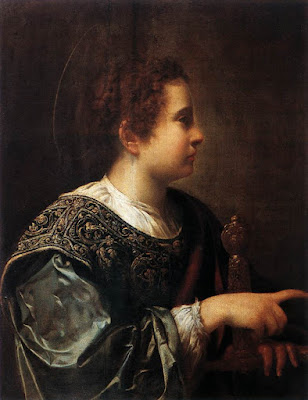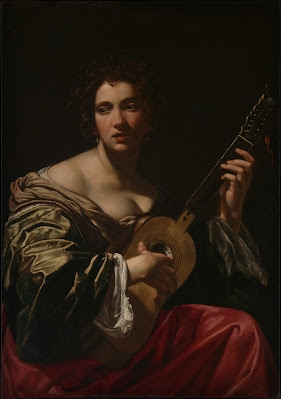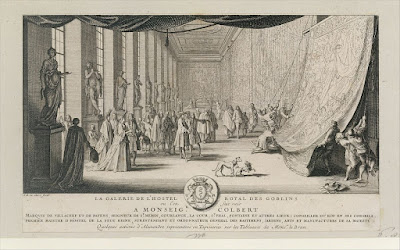Self-Portrait, 1626–1627, made towards the end of his long
stay in Rome as a protégé of Pope Urban VIII and
Cardinal del Monte, and just before Louis XIII,
having financed the visit, recalled him to France in 1627.
It may have been painted as a marriage gift to his new wife Virginia
Vezzi, a talented and beautiful pupil whom Vouet married in 1626,
the same year as he began the self-portrait.
It is now in the Musée des Beaux-Arts de Lyon.
https://en.wikipedia.org/wiki/Simon_Vouet
http://www.visual-arts-cork.com/old-masters/simon-vouet.htm
https://en.wikipedia.org/wiki/Virginia_Vezzi
Simon Vouet … Day 2 …
A “born painter” and son of a painter, travelled to England
to fulfil a portrait commission aged 14 … aged 21 he was with the French
Ambassador at Constantinople to portray Mustafa I … with a grant for study from
the King of France, he travelled from there to Venice where he stayed two years
… there isn’t much, if any, of his work from that period that survives … but,
having learned everything there was about allegories and altarpieces in Venice,
he was ready for full-time work and study in Rome, arriving there in 1613 …
Here’s a Mary Magdalene from 1615, and a St Catherine from
the same time … and some lovers who might have been painted as early as 1614 …
the “weird” thing is that so far I’ve found none of his works from the time
before his arrival in Rome … I’d really like to see some if anyone knows …
Simon Vouet … Day 3 …
Two of his early Roman paintings … same popular subject …
The Fortune Teller, 1617 … This one is still in the
Barberini Palace … Maffeo Barberini was his patron from the start.
The Fortune Teller, 1620
https://www.gallery.ca/collection/artwork/the-fortune-teller-0
... to be continued ...
Simon Vouet … Day 4 …
I guess Simon Vouet was as fond of music as the next man …
Woman with Guitar, c1618
The Met has several pages of notes …
https://www.metmuseum.org/art/collection/search/747607… and I think we
can safely assume Simon Vouet was a connoisseur of fine wimmin …
Simon Vouet … Day
5 … Simon Vouet … Day 5 …
Vaguely allegorical … Martha Rebukes
Her Vain Sister Maria Magdalena, painted around 1621-ish … what do you think of
Maria’s “come-back-to-bed” eyes ?
www.khm.at/de/object/2cad8fa47b/
Here’s an interesting bit of context concerning a pupil of Simon Vouet … https://mydailyartdisplay.wordpress.com/2012/01/24/martha-rebuking-mary-for-her-vanity-by-guido-cagnacci/
Simon Vouet … Day 6 …
David With The Head of Goliath, 1622 … Simon Vouet travelled up to to Genoa to work for the immensely powerful Doria family for a while … as had
Rubens before him …
https://www.museidigenova.it/en/david-head-goliath
He had already portrayed one of their Princes, Marcantonio
Doria, in 1621 … convincing, but not
very flattering, really ! https://en.wikipedia.org/wiki/Doria_(family)
Simon Vouet … Day 7 … perspective …
I think this is one of the most interesting drawings of the early 17th century, yet I haven’t been able to find a larger image to download …
However, a well thought-out essay from Spain on the content
of this drawing, details its intellectual and scientific context … it contains
both an excellent account of the intellectual life in Rome, and of Vouet’s
integration into Roman life, and his achievements while he was there.
http://www.rhinoresourcecenter.com/pdf_files/146/1465290121.pdf
and here is a note from The Met about a famous printed copy
https://www.metmuseum.org/art/collection/search/393576
Simon Vouet … Day 8 …
Having been recognized as an
exceptional painter, Simon Vouet was able to run a studio with assistants … and
several pupils … one of whom was the young Virginia Vezzi … she often modelled
for him, and she INSPIRED him … right from the start , I think … this is
thought to be a study of her face …
… and Virginia had a nice sister,
too, named Ursula, whom Simon Vouet portrayed with the attributes of St.
Catherine …
Simon Vouet … Day 9 …
A commission from around 1624 for Cassiano del Pozzo, Secretary to Cardinal Barberini.
Cassiano was an eminent collector and communicator who made a lifelong
effort to spread scientific enlightenment and a spirit of disciplined enquiry
across the continent.
https://en.wikipedia.org/wiki/Cassiano_dal_Pozzo
Simon Vouet … Day
10 …
Portrait of Artemisia Gentileschi … 1623-1626-ish …
Simon Vouet and Virginia Vezzi were very friendly with
Artemisia Gentileschi and her father, both very well-known painters. I expect
you already knew about Artemisia, but it is still worth scrolling through this
excellent presentation …
https://artsandculture.google.com/story/the-39-excellent-and-learned-39-artemisia-the-national-gallery-london/pQUhlzbRvuAtnA?hl=en&fbclid=IwAR0xAGntpGocQ1qZh8-9-K0Woh3XiH6iGTZE496iakN351fcvrGXNJeK4aU
Simon Vouet … Day
11 …
Simon Vouet became the Pope’s Painter when his Roman patron,
Maffeo Barberini, already in positions of great power for 20 years, finally
took over as Bishop of Rome in 1623.
Simon was required to provide work inside his Great Church … Saint Peter’s itself … these are just
preparatory sketches …
Preparatory work for an Altarpiece in the Vatican, 1625 https://collections.lacma.org/node/214957
On becoming Pope Urban VIII, Maffeo Barberini was able to manufacture weapons and to conduct wars. His inquisitors also persecuted Galileo, an act of ludicrous futility. This lively bust was commissioned from the genius Bernini.
https://en.wikipedia.org/wiki/Pope_Urban_VIII
https://en.wikipedia.org/wiki/Gian_Lorenzo_Bernini
Simon Vouet … Day 12 …
Simon came to Rome to learn, latterly at the expense of the King of France … I think these two studies from 1625-ish show just how skilled and subtle he had become …
… handsome young Italians posing as Saints John & Luke …
1622/1625-ish
https://www.philamuseum.org/collection/object/83656
https://www.philamuseum.org/collection/object/83657
Simon Vouet, Day 13 …
Rome’s churches competed for magnificence, creating an endless
demand for images of saints and prophets and apostles, St. Jerome for instance
…
Saint Jerome and The Angel, 1625-ish …
Jerome was the extraordinary 4th Century scholar
and dedicated ascetic who produced most of the abiding Latin text of The Bible,
translated from Greek, which is called The Vulgate. He also translated some books from Hebrew,
and some from Aramaic.
https://en.wikipedia.org/wiki/Jerome
https://en.wikipedia.org/wiki/Vulgate
https://www.nga.gov/collection/art-object-page.46151.html#provenance
Simon Vouet … Day 14 …
A prosperous life in a prosperous
Roman parish must have been very agreeable … especially once he became
President of the Academy in 1624, aged 34
… yet sometimes, he painted kids … were they his own ? Probably not … because the dates don’t quite
match.
A dealers’ notes shed light on everyday life in Rome …
https://www.robilantvoena.com/exhibitions/82/works/artworks117/
Was this the same child, perhaps ?
Simon Vouet … Day 15 …
This painting first drew me to Simon Vouet.
In my own lifetime, it was held in the studios of William
Drown, the British picture restorers, from whence it was sold to The Prado in
1954 … Why did it escape us ? Whatever
were the directors of London’s National Gallery thinking of ?
The sense of movement and momentum and animation is
uncommonly intense, and I think the lady on the right looks remarkably like
Virginia Vezzi, Mrs Vouet. Eat your
stodgy old miserabilist heart out, Nicolas Poussin !
Time Defeated by Hope And Beauty, 1627
Simon Vouet … Day 16 …
Until the late twentieth century, critics and historians
tended to dismiss Vouet’s ways of thinking as rarther lightweight, a pedant’s
knee-jerk response to the artist’s good humour.
The evidence suggests otherwise. The company he kept included all kinds of
intellectual and philosophical heavyweights who might not have tolerated a
lesser man.
This facet of Vouet’s personality is illuminated with great clarity by Saskia Rubin’s scholarly essay on Vouet’s working relationship with the fine engraver Claude Mellan …
http://www.museejenisch.ch/docs/ClaudeMellan_dossierpresse_01.pdf
Simon Vouet … Day 17 …
Known as Virginia da Vezzo in France, AKA Virginia Vezzi,
AKA Madame Vouet … they had married in
Rome in 1626, just before moving to Paris in 1627 …
Here she poses as Mary Magdalen … in the year 1627, in France.
Ah, that latent smile, not
convincingly penitent. His delicate
observation of her facial expressivity seems unusual, even in the sophisticated
art of this period, a kind of realism which speaks well of Vouet’s reliability
as a portraitist.
https://collections.lacma.org/node/247903
Los Angeles County Museum of Art have photographed the
painting in ultra-fine detail … there is a downloadable image in tiff format …
but be aware it occupies a file of 247MB
https://en.wikipedia.org/wiki/Virginia_Vezzi
Simon Vouet … Day 18 …
Here is Psyche, timidly Approaching Her Own Bed and
Expecting to Find and then Have to Kill a Monster she had previously
Encountered in the Dark ... Pleasurably, Several Times … but only now Discovering
that Cupid Himself had been her Mystery Visitor … painted around 1627.
Let your eye follow the line of Cupid’s red bow on the left,
up the back of Psyche’s arm, then up-and-down the edges of the red curtain to
the bottom corner of the picture … Simon Vouet was really-blatantly-exuberantly
good at “smoothing-out” and “joining-up” the spaces in his
compositions …
Cupid & Psyche was one of the most popular subjects for
painters and sculptors and writers for centuries … it was a long and
complicated myth that has invited many interpretations, and quite a few altered
or revised tellings … and new tellings will always come along … just so long as
Men Continue To Behave Like Monsters, anyway …
https://en.wikipedia.org/wiki/Cupid_and_Psyche
Simon Vouet … Day 19 …
Louis XIII,
1636/1638 ?
https://collections.louvre.fr/ark:/53355/cl010062003
Having worked very happily for tyrannical war-mongering Pope
Urban VII, Simon Vouet returned to Paris after a long absence, and became a
working resident of The Louvre, which was then the Palace of Louis XIII,
another despotic war-monger … ah, those
were the days my friend !
The Louvre’s catalogue says the women allegorically
represent the nations of France and Navarre.
I couldn’t say if Louis was an interesting or even likeable
character … his dominating Italian mother may have murdered his French father …
but he certainly led an interesting life …
https://en.wikipedia.org/wiki/Louis_XIII
Simon Vouet … Day 20 …
Paris constantly demanded interior decorators … artists like
Vouet worked with large teams of assistants, their studios were like factories … as
The King’s Painter, Vouet’s studio was the largest in Paris …
Ceres with some Harvesting Putti, probably painted around 1634, would have been painted in a hurry with much of the landscape work done by Vouet’s assistants, so it is probable that only the figure of the goddess was added by Vouet himself at the end … nevertheless, Vouet’s arrival from Italy, closely following Rubens’ grand entrance, brought a new level of Baroque sophistication to French Art and Design.
https://artuk.org/discover/artworks/ceres-and-harvesting-cupids-114414
https://www.nationalgallery.org.uk/paintings/simon-vouet-and-studio-ceres-and-harvesting-cupids
Simon Vouet … Day 21 … Diana …
Signed and dated in 1637, given to Charles I and Queen
Henrietta, and still owned by Queen Elizabeth.
The King of France’s little sister, Henrietta Maria, married
Charles the First of England in 1625, when she was 15 and he was 25. Henrietta Maria was a trained horsewoman,
hence a tenuous connection with Diana the Huntress … possibly.
In those days, teenage princesses were “traded” as child
brides in return for alliances & dowries, and the groom didn’t even have to
attend the wedding, the vows being declared by a trusted representative, or
Proxy.
Whatever ignominies Henrietta endured after leaving France, she never forgot how to Spend, Spend, Spend.
https://www.rct.uk/collection/search#/1/collection/403930/diana
QUOTE : In this rare single
figure composition Vouet explores the idea that Diana exhibits a wild and
‘natural’ kind of beauty, as opposed to the artifice of Venus. The original
oval shows more of the rough rocky terrain in which the huntress has strayed
and risks become benighted. Her only ornament is provided by her dogs’ leads
wrapped around her upper arm exactly where Venus wears a gold bracelet (for
example in the ‘Crouching Venus’ in Charles I collection, RCIN 69746, on loan
to the British Museum). Her posture makes a crescent shape and she reflects a
cool, silvery light as if imitating the properties of her attribute, the moon.
https://en.wikipedia.org/wiki/Diana_(Vouet)
https://en.wikipedia.org/wiki/Henrietta_Maria
Simon Vouet … Day 22 … Muses …
I guess The Muses were thought to be useful role models for the women in the palaces … as well as being food for thought for anyone who might have idly questioned the purpose and usefulness of womankind, if any.
The Muses Urania and Calliope, 1634
The Muse Erato, 1638-ish
The Muse Euterpe, 1638-ish
Simon Vouet … Day 23 …
Allegories, usually of Virtues or of Senses, were one of the
main sources of narrative content ( and eye-candy for the artist’s male patrons
) in Baroque art, however enigmatic.
Court painters would have always been hurrying to fit them
in to new wall or ceiling spaces whenever the spendthrift Kings & the
Nobility were in a frenzy of self-aggrandisement.
La Volonté, L’Intellect, et La Mémoire … painted in Rome … Volonté represents the exercise of reasoned judgement, Memory has two faces looking forward and back, Intellect writes on a tablet and has the flame of inspiration.
The second, from 1640, is an Allegory of Faith & The
Contempt for Wealth, ( as if you didn’t know already ) …
https://collections.louvre.fr/en/ark:/53355/cl010061999
https://www.researchgate.net/publication/297330832_New_interpretations_of_the_allegories_by_Simon_Vouet_in_the_collections_of_the_Louvre_and_Versailles
Simon Vouet … Day 24 …
not too bad at drawing, neither … proper painters never stopped drawing … a bit like tennis players who must practice every day to maintain their skills.
Simon Vouet … Day 25 …
Vouet’s big Paris studio knocked out
a lot of religious commissions … this was the age of the powerful Cardinal
Richelieu, after all.
So … When Is A Kiss Just a Kiss ? … Really ? Are you quite sure ? Just look at her closed eyes … just look at
her hands … the artist certainly understood divinely ecstatic tenderness.
Madonna and Child, 1633
National Gallery of Art, Washington DC
https://www.nga.gov/collection/art-object-page.206070.html
Simon Vouet … Day 26 …
Louis XIII’s Queen, AKA Anne of Austria, posing as Minerva …
a piece of flattery that was intended to reflect well on Louis’ choice of a Spanish Hapsburg for a child bride. It was an arranged marriage and it became a difficult marriage, but she was his wily survivor and the long Wikipedia article is worth reading.
https://srv1.hermitagemuseum.org/wps/portal/hermitage/digital-collection/01.+paintings/37067
https://en.wikipedia.org/wiki/Anne_of_Austria
Simon Vouet … Day 27 …
Ceres, Adonis, Flora and Bacchus represent the Four Seasons in this Tondo from Ireland’s National Gallery.
http://onlinecollection.nationalgallery.ie/objects/5073/the-four-seasons
Simon Vouet … Day 28 … the Gobelin tapestry works
As the King’s Painter, Vouet and his studio were required to
provide countless designs for the King’s other artistic enterprises such as the
Gobelin’s tapestry works.
This fairly typical tapestry is 9 feet high and 15 feet long.
http://www.deroyan.fr/en/tapestries/gobelins-m%C3%A9tamorphoses-dovide/
https://www.parisinsidersguide.com/gobelins-paris.html
Other tapisseries … https://collections.louvre.fr/en/recherche?q=Tapisserie%20Simon%20Vouet&typology%5B0%5D=5&author%5B0%5D=2325
The Met has a very useful general introduction to the
subject of the tapestry industry & mentions Vouet’s importance … https://www.metmuseum.org/toah/hd/tapb/hd_tapb.htm
Simon Vouet … Day 29 …
Much of Vouet’s time was spent on lavish interior design schemes for great houses and churches … and of course, much of that work has since vanished … but Simon Vouet’s eminence as the King’s Painter was suddenly eclipsed by the return of Poussin from Rome in 1642 … and then Louis XIII died in 1643 … Ann of Austria became Regent until Louis XIV “ascended” in 1651 … every contract with the deceased King became null & void … Simon Vouet lost out to the next generation of artists and designers, led by Le Brun … Vouet died in 1649 but his Baroque style continued to be influential … and even after he died, prints and books of his designs were sold as models of “good taste” …
A tapestry of St. Nicolas was even adapted to proclaim the
sober principles of the Wine Merchants’ Guild in 1650.
https://bibliotheque-numerique.inha.fr/viewer/34855/?offset=#page=1&viewer=picture&o=bookmarks&n=0&q=
Simon Vouet … Day 30 …
Here are a couple of Saint Sebastians for the lads …
When I first went to Spain, a gay professor in Madrid had to
explain to me how important Sebastian’s image had been to gay men in Fascist
Spain, and in the wider Catholic world … both as a symbol or emblem of their own
public persecutions and private martyrdoms … and as a focus for their thinly
concealed empathies, and desires …
I reckon Simon Vouet and his sophisticated clientèle must have already known …
Simon Vouet … Day 31 …
Problems of attribution … Master or Pupil ?
Simon Vouet was an excellent teacher and Eustache Le
Sueur was his eminent pupil … so …
Q. Is this action-packed melodrama … either Tarquin and
Lucrece by Simon Vouet ? ... or is it The Rape of Tamar by Eustache Le
Sueur ? Some have argued the composition
is too sophisticated to be one of Le Sueur’s …
The painting, held at the Met, is the subject of an
interesting controversy ( dispute, or squabble ) … over who painted it … and
over who should own it. I am not
qualified to take sides.
https://travel.joopeter.de/history-vouet-2
























































